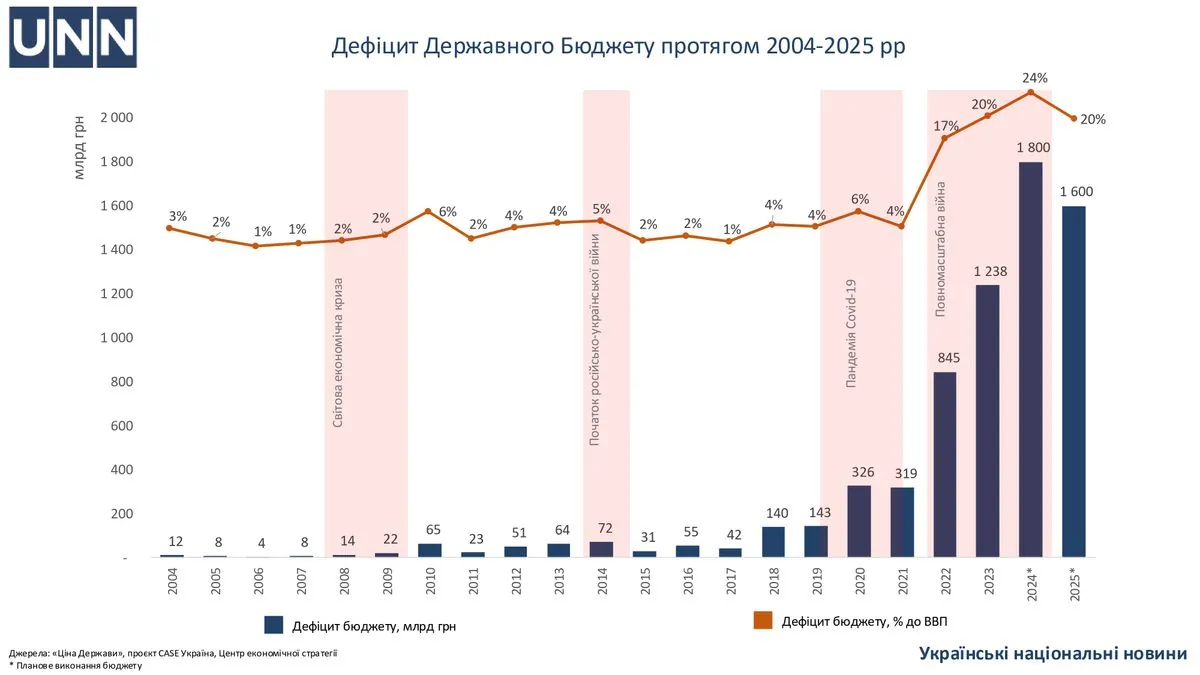How the Ukrainian state budget deficit has changed over the past 20 years
Kyiv • UNN
Over the past 20 years, Ukraine's state budget deficit has gone from surplus to record levels. Economic crises, political changes, and global challenges have significantly affected the country's financial stability.

Over the past 20 years, Ukraine's state budget deficit has shown significant fluctuations, reflecting economic crises, political changes, and global challenges. From surpluses in the early 2000s to record levels during the pandemic and full-scale war, the budget deficit has become a permanent part of the country's economic life. UNN conducted an analysis of the deficit dynamics, which allows us to better understand how economic and social processes affect the financial stability of Ukraine.
First, we need to understand what the state budget and its deficit are.
The state budget is the main fund of the country's centralized funds. Through it, the state accumulates a portion of the gross domestic product (GDP) and distributes it for economic development, social protection, the functioning of government and administration, and defense.
Every year, the budget is approved by the Verkhovna Rada of Ukraine as a law.
If budget revenues exceed expenditures, it is called a budget surplus, and if vice versa, it is called a budget deficit.
A deficit is caused by a reduction in revenues or an increase in expenditures and can lead to inflation.
Budget revenues are generated mainly from taxes, fees, and other sources, such as privatization of state property.
Budget deficits are commonplace in most countries, and they are also chronic in Ukraine. This has an indirect impact on the population, as the debts raised to cover the deficit are repaid through taxes.
There is no country in the world that does not have a budget deficit. Almost all countries in the world use the mechanism of external financing. They issue Eurobonds and sell them, and the largest debtor in the world is the United States
He emphasizes that budget deficits are common for most countries, with the only exceptions being those that do not have them.
"Working with international financial organizations is a commonplace. The issue is different, the size of the loan in relation to the country's GDP. For an economy like Ukraine's, a debt of 60% of GDP is normal. Now we have a debt of 100% of GDP. Even if the war is over, Ukraine will still be attracting external financing," he added.
In the period from 1996 to 2003, the state budget deficit of Ukraine experienced significant fluctuations. In 1996, the budget deficit amounted to 4.9% of GDP. Subsequently, due to fiscal policy measures, this figure gradually decreased, reaching 1.5% in 1999.
In 2000, a budget surplus of 0.6% of GDP was recorded for the first time. This trend continued in 2002, when the surplus amounted to 0.7% of GDP. However, in 2001 and 2003 there was a slight budget deficit of 0.3% and 0.2% of GDP, respectively.
Since the beginning of 2004, the budget deficit has amounted to UAH 12 billion, with a 3.4% share of GDP.
Already in 2005, the deficit decreased to UAH 8 billion, or 1.8% of GDP. In 2006, the deficit was halved to UAH 4 billion, or 0.7% of GDP.
In 2007, there was a deficit of UAH 8 billion, i.e. 1.1% of GDP, and it should be noted that this was the beginning of the crisis or "Great Recession".
Even at the height of the crisis, in 2008, the deficit amounted to 14 billion and 1.5% of GDP. In 2009, the budget deficit continued to grow to 22 billion and 2.4% of GDP.

The new decade, in 2010, the deficit was already 65 billion and 6.0% of GDP.
In 2011, the deficit decreased significantly to UAH 23 billion and 1.8% of GDP.
In 2012, the deficit was actually twice as large - UAH 51 billion and 3.5% of GDP.
Over the next two years, the deficit continued to grow: in 2013, it amounted to UAH 64 billion and 4.2% of GDP, and in 2014, it was UAH 72 billion and 4.5% of GDP.
2015 - 31 billion and 1.6% of GDP.
In 2016, it was 55 billion and 2.3% of GDP.
In 2017, the deficit decreased to UAH 42 billion and 1.4% of GDP.
Already in 2018, the budget deficit was UAH 140 billion and, accordingly, 4.0% of GDP.
During the Covid-19 pandemic in 2019, the deficit amounted to UAH 143 billion and 3.6% of GDP.
The pandemic continued in 2020, and the budget deficit amounted to UAH 326 billion and 6.0% of GDP.
In 2021, the deficit decreased slightly to UAH 319 billion and 3.6% of GDP.
With the start of the full-scale invasion in 2022, the budget deficit amounted to 845 billion and 17.1% of GDP. In 2023, it was UAH 1238 billion and 20.4% of GDP.
In 2024, the projected state budget deficit will reach UAH 1,800 billion, which is about 24% of GDP.
However, the draft state budget for 2025 sets the deficit at UAH 1,600 trillion, which is almost 20% of the projected GDP.
Recall
The Cabinet of Ministers has approved the draft budget for 2025 with expenditures of UAH 3.7 trillion.